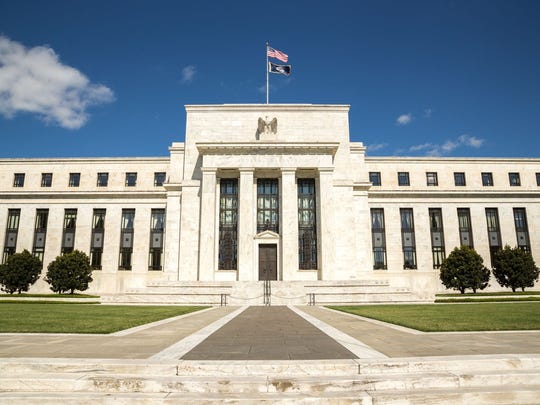In solid economy, Fed holds rates steady after 3 cuts in 2019 in wait-and-see approach
The U.S. economy keeps chugging along but overseas risks such as the coronavirus continue to hover, and that’s helping keep the Fed in wait-and-see mode.
As widely expected, the Federal Reserve held interest rates steady Wednesday, following through on its vow late last year to stand pat barring a “material” change in its outlook.
In a statement after a two-day meeting, the Fed said it would leave its benchmark federal funds rate at a historically low range of 1.5% to 1.75% after cutting it by a quarter percentage point three times last year amid trade tensions and sluggish global growth that increased the risk of recession.
Fed Chair Jerome Powell has said the so-called insurance cuts kept the economy on solid footing and no further decreases were needed unless the outlook darkened.
“Uncertainties about the outlook remain, including those posed by the new coronavirus,” Powell said at a news conference Wednesday. “There is likely to be some disruption to activity in China and globally” from the virus.
But, he added, “It’s too early to say what the effect will be” in the U.S. “We are monitoring it carefully.”
Chinese authorities have confirmed 5,500 cases and 131 deaths from the virus. There have been five cases in the U.S.
In its statement, the Fed said “the labor market remains strong” and “economic activity has been rising at a moderate rate.” The central bank downgraded its view of consumer spending, describing the recent rise as “moderate,” rather than “strong,” as it said in December. Business investment it said, remains “weak.”
Since the Fed’s December meeting, consumer spending has slowed but continued to perform well while business investment remains sluggish. And although manufacturing has contracted for five straight months, industrial output has picked up somewhat and housing starts have increased sharply as a result of low mortgage rates.
Economists surveyed by Bloomberg expect the government on Thursday to report the economy grew at an annual rate of 2.2% in the fourth quarter. And those polled by Wolter Kluwer Blue Chip Economic Indicators predict 1.9% growth next year. Both estimates mark a slowdown from the nearly 3% gain in 2018 – a pace bolstered by President Trump’s tax cuts and government spending increases — but are higher than prior forecasts.
At the same time, the Fed noted Wednesday that inflation remains below its 2% target. Powell has said it would take “a significant increase in inflation” for the Fed to raise rates.
(Photo: Getty Images)
No, not that Corona: The coronavirus has nothing to do with Corona beer. But, some people seem to think so.
Virus fallout: Some US businesses restrict travel to China, close stores because of coronavirus as economic fallout spreads
Some of the risks that worried Fed officials last year have eased. The Trump administration has reached a “phase 1” trade agreement with China. Congress has passed a new trade deal with Mexico. And the odds of a chaotic British withdrawal from the European Union have dropped.
But new hazards have emerged, Barclays says. The coronavirus threatens to crimp growth in China and other parts of Asia and could jeopardize the U.S. economy if it spreads. U.S.-Iran tensions persist. Boeing has halted production of its 737 MAX at least until summer after two fatal crashes, a development that Moody’s Analytics says will trim nearly half a percentage point off growth in the current quarter. And there’s some question about whether China will fully honor its agreement to buy more American exports under the trade deal.
Meanwhile, President Trump is still waging broader trade battles with China and Europe. Although the partial trade deal with China seems to have boosted manufacturers, “There’s a bit of a wait-and-see attitude,” Powell said. “Is this going to be sustained?”
Powell also said the Fed plans to continue purchases of Treasury bonds and other assets at least until spring to pump cash into the financial system after a cash shortage last fall briefly pushed the federal funds rate above the Fed’s target range. The Fed has bought about $400 billion in the securities since October.
He said the central bank will then gradually reduce the purchases and stop them when it’s confident of maintaining at least $1.5 trillion of reserves in the system.
Powell stressed again that unlike the Fed’s massive bond purchases during and after the Great Recession of 2007-09, known as quantitative easing, the latest purchases aren’t designed to stimulate the economy and markets by lowering long-term interest rates. For example, the Fed is buying short-term rather than long-term bonds.
“It’s not intended to represent a change in the stance of monetary policy,” Powell said.
Still, Kathy Bostjancic, chief financial economist for Oxford Economics, is among analysts who believe the initiative has prompted some investors to move money from low-yielding bonds to stocks and other riskier assets, juicing the market.
As a result, she’s concerned the Fed’s planned tapering of the purchases could hurt stocks despite Powell’s assurances.
Where’s my money?: How long will it take to get my tax refund this year?
Federal Reserve Chairman Jerome Powell is asking Congress to tackle the growing budget deficit.
AP Domestic
Source: Read Full Article
